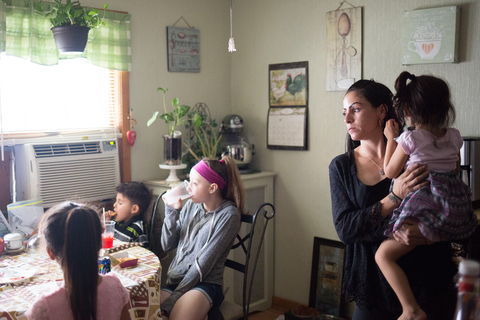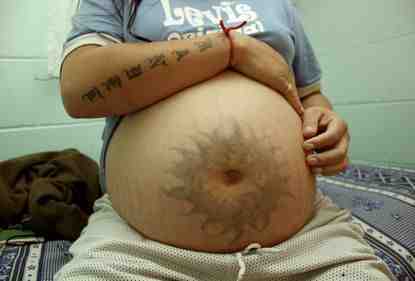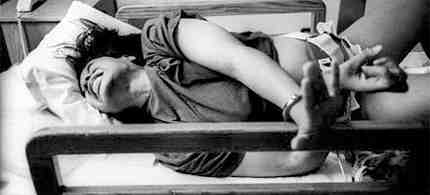Indiana Law Now Says Pregnant Inmates Can’t Be Shackled to a Bed During Childbirth
Indiana Governor Eric Holcomb (right) signed a law on Thursday that makes Indiana the latest state to ban the practice of shackled pregnant prisoners during childbirth. The bill was passed unanimously in the Indiana House and Senate.
The law stipulates that birthing centers must include obstetric and neonatal level certification, and must comply with the certification requirements of the American Academy of Pediatrics and the American College of Obstetricians and Gynecologists. Further, it mandates that correctional facilities use “the least restrictive restraints required on pregnant inmates when pregnant inmates are in the second or third trimester of pregnancy,” and that they use “no restraints on pregnant inmates who are giving birth, delivering infants, during this period. immediately after delivery, or dealing with medical emergencies related to pregnancy.” The law does provide some exceptions to the prohibition on shackles.
The change means Indiana has joined a growing effort across the country to bring the practice in all American correctional facilities in line with recommendations for the humane treatment of detainees. United Nations guidelines for minimum standards for the care of prisoners require that “containment devices shall never be used … during labour, during birth and immediately after birth.” Likewise, the American Medical Association calls shackles during childbirth a “barbaric practice that unnecessarily causes excruciating pain and humiliation.”
The 2018 federal First Steps Act prohibits the use of shackles during childbirth at the federal level, but still leaves open the possibility that women in state and county prisons will be shackled. Only three states – New York, Illinois, and California – completely outlaw shackles during childbirth, while 24 other states have banned it with certain exceptions.
In “The Realities of Pregnancy and Mothering While Incarcerated,” a 2021 article in the American Journal of Psychiatry and the Law, authors Susan Hatters Friedman, Aimee Kaempf, and Sarah Kauffman provide context about the growing number of female inmates in the US, “a lot” in the United States. of them were pregnant while they were in prison:
The United States has the second highest rate of imprisoning women internationally, second only to Thailand. In recent decades, there has been a dramatic increase in the US correctional population, and women are a rapidly growing segment of this population. In the United States, 64.6 women per 100,000 are incarcerated, with the highest rate of 142 per 100,000 occurring in Oklahoma. Most of the imprisoned women are in their reproductive years, and many pregnant women at reception.
About one in 40 (2.3%) US children have a parent in prison.
Rita Fleming (D), a retired OB-GYN who wrote the law, called the practice of shackles during childbirth “unnecessary, “inhumane” and “unsafe.” Many proponents of the law say the law is motivated in part. to combat infant mortality in Indiana.According to official records, Indiana’s infant mortality rate is 77.2 per 100,000 live births in 2020.
[image via Scott Olson/Getty Images]
Got any tips we should know? [email protected]
What punishments are cruel and unusual?

Penalties prohibited by the Eighth Amendment of the Constitution. Cruel and unusual punishments include torture, deliberately degrading punishment, or punishment that is too severe for the crime committed. This may interest you : Omicron surges: Indiana reports record 12,960 new COVID-19 cases. This concept helps guarantee due process even for convicted criminals.
What is the toughest punishment? The death penalty is our toughest punishment (3). It is irrevocable: it ends the existence of those convicted, instead of imprisoning them temporarily. Furthermore, although not intended to inflict physical pain, execution is the only corporal punishment still applied to adults (4).
What are examples of cruel and unusual punishment?
Cruel and unusual punishments refer to punishments that fail to meet standards of social decency – are too painful, torture, humiliating, or humiliating (e. On the same subject : Does Indianapolis have a train?.g., evisceration, beheading, public dissection and burning alive) or are grossly disproportionate to the crime committed. conducted.
What are some examples of the 8th Amendment?
Example of the 8th Amendment
- Excessive warranties or fines.
- Excessive coercion or brutal treatment.
- Unsafe prison conditions.
- Unsanitary prison conditions.
How do you determine if a punishment is cruel and unusual?
In this way, the United States Supreme Court “sets the standard that a sentence will be cruel and unusual [if] it is too severe for the crime, [if] it is arbitrary, if it offends the public’s sense of justice, or if it is not more effective than punishment.” lighter.”
What right is cruel and unusual punishment?
Summary. The cruel and unusual punishment is a phrase mentioned in the Eighth Amendment to the US Constitution. Read also : Indiana reports 2,969 new COVID-19 cases; death toll rises to 21,191. In particular, the Eighth Amendment prohibits cruel and unusual punishments.
What is the 8th Amendment called?
The Eighth Amendment (Amendment VIII) of the United States Constitution prohibits the federal government from imposing excessive bail, excessive fines, or harsh and unusual penalties. These amendments were adopted on December 15, 1791, along with other United States Bills of Rights.
Is cruel and unusual punishment a civil right?
Excessive bail will not be required, nor excessive fines, nor cruel or unusual penalties imposed. The prohibition of “cruel and unusual punishment” first appeared in the English Bill of Rights, in 1689. … It became part of the US Bill of Rights in 1791 as the Eighth Amendment to the US Constitution.
What 3 Rights are protected by the 8th Amendment?
The Eighth Amendment of Protection Against Cruel Punishment, Excessive Guarantees, and Excessive Fines. The Eighth Amendment provides three important safeguards for those accused of a crime, in addition to those found in the Fifth and Sixth Amendments: It prohibits excessive bail and fines, as well as cruel and unusual punishments.
How is the Eighth Amendment violated?

A prison guard’s willful indifference to a prisoner’s illness or serious injury would constitute a cruel and unusual punishment that would violate the Eighth Amendment.
What happens if you violate the 8th Amendment? A life sentence without parole may be acceptable for some crimes, but it would violate the Constitution to sentence anyone to death in prison for shoplifting or simple marijuana possession.
What 3 things does the 8th Amendment forbid?
The Eighth Amendment of Protection Against Cruel Punishment, Excessive Guarantees, and Excessive Fines. The Eighth Amendment provides three important safeguards for those accused of a crime, in addition to those found in the Fifth and Sixth Amendments: It prohibits excessive bail and fines, as well as cruel and unusual punishments.
Which does the 8th Amendment forbid quizlet?
What is the 8th Amendment? Excessive bail should not be required or excessive fines, or cruel and unusual penalties imposed. 8 The amendment prohibits excessive bail, bail may be denied in major cases (involving the death penalty and when the accused threatens witnesses who may be present.
What does the 8th Amendment ban?
The Eighth Amendment to the United States Constitution states: “Excessive bail shall not be required, nor excessive fines, nor cruel and unusual sentences imposed.” This amendment prohibits the federal government from imposing excessive sentences on criminal defendants, either as a price to get…
What are the three clauses of the 8th Amendment?
It contains three clauses that limit the amount of bail associated with a criminal offense, the fine that can be imposed, and the penalty that can be imposed.
What is illegal under the 8th Amendment?
The Eighth Amendment (Amendment VIII) of the United States Constitution prohibits the federal government from imposing excessive bail, excessive fines, or harsh and unusual penalties. These amendments were adopted on December 15, 1791, along with other United States Bills of Rights.
What is forbidden under the 8th Amendment?
The Eighth Amendment to the United States Constitution states: “Excessive bail shall not be required, nor excessive fines, nor cruel and unusual sentences imposed.” This amendment prohibits the federal government from imposing excessive sentences on criminal defendants, either as a price to get…
What 2 things does the 8th Amendment forbid?
Most often mentioned in the context of the death penalty, the Eighth Amendment prohibits cruel and unusual punishments, but also mentions “excessive fines” and bail.
Which does the 8th Amendment forbid quizlet?
What is the 8th Amendment? Excessive bail should not be required or excessive fines, or cruel and unusual penalties imposed. 8 The amendment prohibits excessive bail, bail may be denied in major cases (involving the death penalty and when the accused threatens witnesses who may be present.
Do defendants wear handcuffs in court?

The decision not to handcuff the accused is standard procedure and part of the defendant’s right to a fair trial, according to Rachel Moran, professor of law at St. University School of Law. Thomas in Minneapolis.
Why were some of the defendants handcuffed? It is often necessary for a criminal defendant to be detained in some way during a trial. The main danger posed by detaining defendants by means such as shackles, chains, or armed guards is that prejudice may form in the minds of jurors upon seeing the accused before them.
Are defendants handcuffed?
Defendant Chained “Full restraint,” as defined by the court, means that “the defendant’s hands are handcuffed together, these handcuffs are linked by chains to another chain that goes around the defendant’s waist, and the defendant’s legs are shackled and chained together.”
What is a handcuff for a prisoner called?
Noun. â–² A pair of connected locking metal rings are used to secure prisoners. shackles. handcuffs.
Will I be shackled in court?
Courts recognize the right of adults not to be shackled, except for urgent security reasons.
What does it mean to be handcuffed to someone?
the verb (used with an object) to handcuff. to detain or thwart (a person) by or ostensibly by handcuffing: Amendments handcuff the committee and prevent further action.
Are handcuffs necessary?
While recommended for most capture situations, handcuffs are an option and not an absolute requirement of the OPS. Officers should consider handcuffing anyone they believe requires that level of restraint.
What is the purpose of handcuff?
Handcuffs are a type of restraint, often used by police to ensure a suspect cannot escape or hurt anyone. They do this by securing one’s wrist. They are usually metal and consist of two parts connected by a chain.
What is the fear of being handcuffed?
Merinthophobia is the fear of being tied down or tied up. The origin of the word merintho is Greek (meaning rope). Merinthophobia is a specific phobia.
Are handcuffs a use of force?
Handcuffs are generally the use of force and the application of the handcuffs should be reasonable. The single message of the court ruling denying qualified immunity is simple: Handcuffing is generally an exercise of force and the application of handcuffs should be reasonable.
Can you give birth in jail?

Nurseries in the United States Most nursery prisons in the United States are only open to mothers who give birth to their children while they are serving their sentences; in most states, women who gave birth before their detention are not eligible, though New York is an exception.
Can prisoners be used for forced labor? Prison work is enabled in the United States by the 13th amendment to the U.S. Constitution which prohibits slavery “except as a punishment for a crime.” More than 2.2 million people are incarcerated in state, federal, and private prisons in the United States , and nearly all able-bodied prisoners work in a certain way.
What happens if you are pregnant and in jail?
When you are pregnant, prisons can – but don’t have to – handcuff you in front of your body. These restrictions apply throughout your pregnancy, while you are in labour, and while you are recovering in the hospital after you give birth. They also apply during travel, for example, to court or hospital.
Can police handcuff a pregnant woman?
Law enforcement and correctional officers are no longer allowed to handcuff, chain the stomach, shackle, or confine teenagers or pregnant women.






Comments are closed.